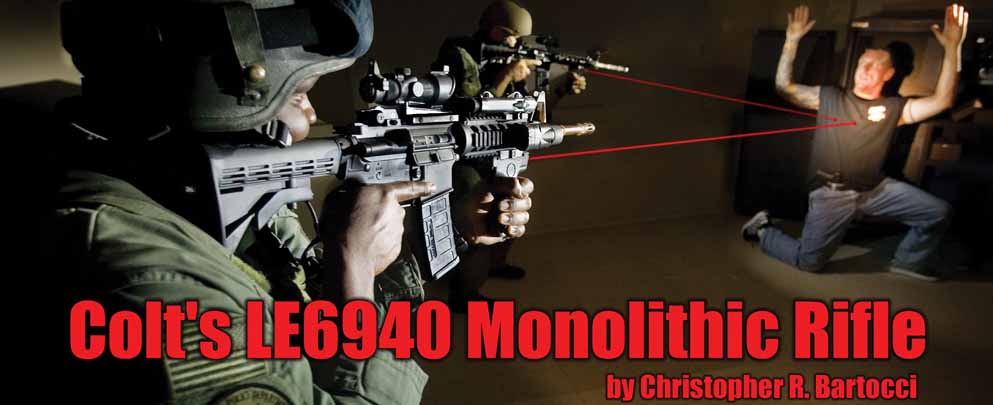By Christopher R. Bartocci
The “Black Rifle” has gone through several incremental changes over the last decade. The industry is vast and there is no shortage of accessories and product enhancements. Although most of them are “gadgets,” some have truly been enhancements that lead the weapon platform into clearly new territory and may define the future configurations of this combat proven family of weapons.
In January, 2009, Colt Defense introduced and began shipping their first new model for the law enforcement community in nearly a decade. The LE6940 is truly the “next level” for Colt’s legendary AR-15/M16/M4 family of weapons. What sets this model apart from the rest is that it is built on Colt’s monolithic upper receiver. This receiver provides multiple enhancements to the weapon.
The 1-Piece Upper Receiver
The upper receiver is a truly monolithic design. Many of the so called-monolithic upper receivers in the industry are actually two pieces welded together. The top rail of the rifle offers a continuous rail from the rear of the receiver to the front sight base. This satisfies zero retention and zero repeatability requirements. Optics may be removed and installed with no effect on zero. The 3 and 9 o’clock rails are also rigid and provide the same zero retention. The barrel itself is fully free floated. This offers several enhancements in accuracy, heat control and durability to the weapon. By having a free floated barrel, accuracy is enhanced as there is no heavy piston or handguard to interfere with the harmonics of the barrel. This feature is used on competition rifles and is essential for precision shooting. The receiver also enhances cooling of the weapon and thus durability is also increased. It is unlike many current rail systems which are made of aluminum or steel and attach at the barrel nut as well as the handguard cap that transfers heat from the front sight base (hottest point of the barrel) back into the aluminum receiver. An additional feature of the Colt design is its barrel extension and nut. There is an increase in the contact area between the barrel and receiver to increase accuracy. The barrel nut also does not have to be aligned with the gas tube.
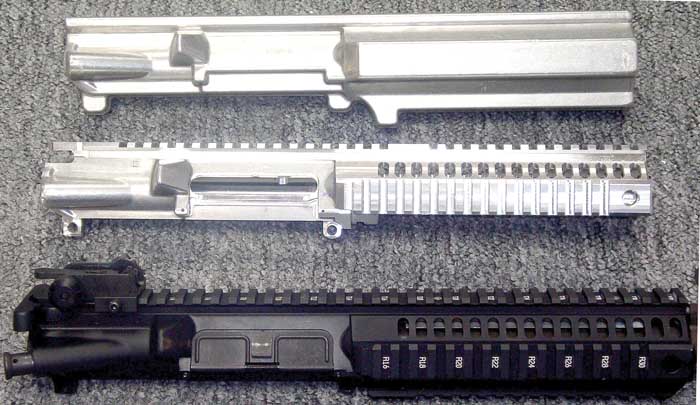
By utilizing the 1-piece upper there is a significant savings of cost and weight compared to purchasing a traditional M4-type carbine. The savings in cost comes from not having to purchase and install an aftermarket rail system as well as a back up iron sight, which are already standard on the LE6940. Experience shows that many military or law enforcement operators will immediately upon receiving an M4-type weapon, remove the handguards and install a rail system and purchase a back up sight.
The LE6940
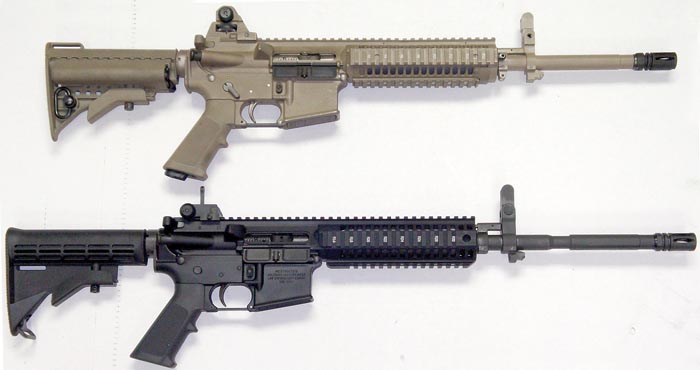
Colt Defense has taken their new monolithic upper receiver and offered it to Law Enforcement. The LE6940 offers the enhanced monolithic upper receiver with a 16.1 inch M4-profile barrel with the step cut. The barrel is the standard GI 1/7 inch twist chrome lined barrel offering the user the ability to fire the full range of projectile weights. The 16.1 inch barrel is perhaps the optimal carbine length barrel for both accuracy and terminal performance of the 5.56mm cartridge in a carbine configuration. Just like the military weapons, every barrel is subjected to a 70,000 psi proof cartridge and then magnetic particle inspected to insure the barrel is free of stress fractures. The rifle comes equipped with the standard A2 compensator. The upper receiver also has a forward assist and a fired cartridge case deflector.

Another outstanding feature is the introduction of the new folding front sight. Unlike most of the folding front sights on the market, the Colt folding front sight base is pinned in place as opposed to screwed on. Pinning the front sight base is significantly more durable and permanent. Due to the pinning process, the front sight base will not loosen and adversely affect accuracy or reliability. The benefit of the folding front sight is enormous when using optics. The standard front sight base often obstructs the view of optics when mounted on the rail of a flat top upper receiver and the shooter has a significantly better field of view with the front sight folded. Most optics as well will allow co-witnessing between the back up sights and the optic in case the battery was to fail or the optic was to become damaged. The front sight base is equipped with a bayonet lug. The Colt folding front sight is robust and positive locking. Another benefit of having the front sight attached to the barrel is when the barrel moves due to thermal expansion the sight moves with it maintaining zero. The production LE6940 uses a quick detach sling swivel, which can be mounted on either mounting point on both sides of the front of the receiver. The lower handguard, which is removable, requires only the push inward of a detent on the rear of the bottom of the handguard. Once the detent is pushed in, the handguard is slid forward and then pulled down. The rail is more robust, easier to remove.
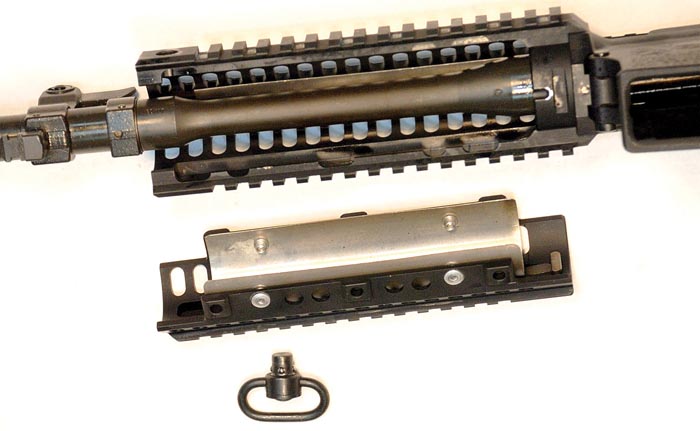
‘ The LE6940 comes standard with the U.S. Government Issue MaTech back up iron sight that is adjustable for both windage and elevation. The elevation is adjustable up to 600 meters and zeroes the same as the standard M4/M16A2 fully adjustable rear sights. The elevation is calibrated for the drop of the M855 ammunition. Windage is easily adjusted with the standard size windage knob.
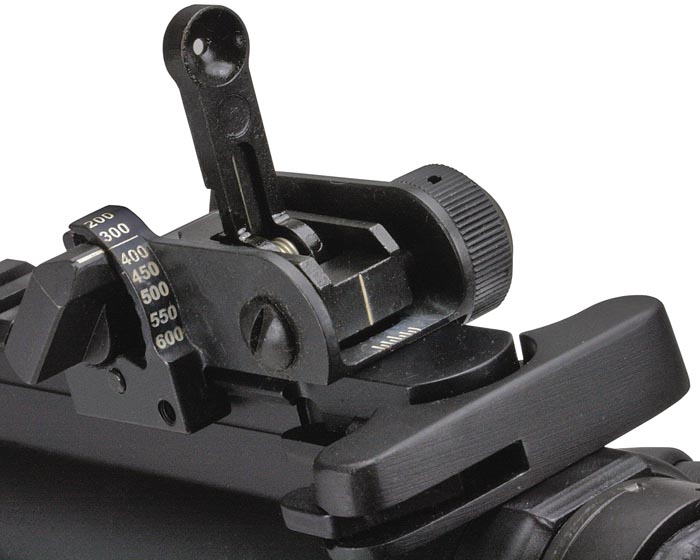
The LE6940 comes with a standard M16 bolt carrier and bolt. The bolt is also test fired with a 70,000 psi proof cartridge and then magnetic particle inspected to insure it is free of stress fractures. The extractor incorporates a Mil-Std extractor spring, which increases extraction reliability.
The lower receiver incorporates a change as well. Since the introduction of the Colt Sporter series semiautomatic only rifles in the early 1990s, Colt has used a larger .170 hammer and trigger pin. This was an effort to prevent conversion to automatic fire. Thus with the larger pins, one could not install selective fire components. This proved to be problematic with Colt customers. By not using industry standard .154-inch diameter hammer and trigger pins, many of the enhanced triggers would not be offered to Colt Sporter and Match Target owners. The LE line of Colt semiautomatic only rifles would also use the .170 diameter hammer and trigger pins. The LE6940 is introduced with a lower receiver which goes back to the standard .154 hammer and trigger pins. This is a result of both customer request as well as parts standardization.

The lower receiver is equipped with the standard GI telescopic stock with four positions allowing for individual adjustment. Another new feature incorporated into the LE6940 is the reversible selector lever. If the shooter is left handed, they only have to unscrew the pistol grip screw, remove the pistol grip and, with the hammer cocked slightly, push down on the hammer and remove the selector lever from the left side and reinstall it in the right side.
The Magpul 20-round PMags were used for all function and firing testing. The test and evaluation rifle was fired off of a bench at 100 yards. The ammunition selected for accuracy testing was Black Hills Mk262 Mod1. This is the special operations 77-grain open tip match Sierra projectile and, in this author’s opinion, is the most accurate out-of-the-box 5.56mm available. Groups maintained 1-1/2 inches at 100 yards using a Trijicon ACOG scope. The trigger on this rifle broke at 6 pounds with little creep. For functioning testing, the 1-piece upper receiver was placed on a selective fire M4 lower receiver. More than 1,000 rounds were fired on automatic with no malfunctions encountered. The sample rifle was equipped with a VLTOR Modstock, PMags, Insight Tech Gear M3X tactical light and KAC vertical pistol grip.
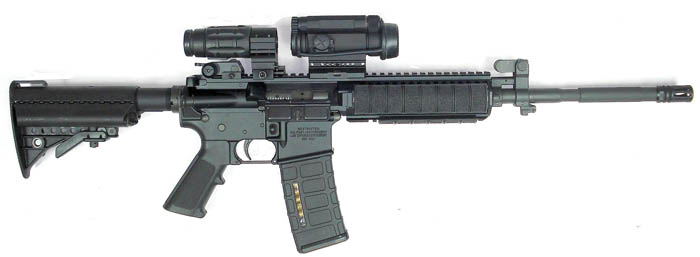

Further Development of the 1-Piece Upper Receiver
The Colt monolithic upper receiver has become a standard in most of Colt’s new weapon designs. Given its versatility of design, it may be used on both direct gas operated rifles as well as piston designed weapons. Colt’s prototypes unveiled at November 2008’s Industry Day held by the Secretary of the Army utilized this 1-piece receiver including the ACC-M (direct Gas), APC-M (piston), SCW (direct gas and piston), Hybrid and the Infantry Automatic Rifle.
Colt’s new weapon began shipping out of the Hartford, CT factory in January of 2009. New models are on the horizon in 11.5, 14.5 and possibly even 20-inch barrel lengths. The monolithic rail platform is a for-sure hit due to all the features offered. Police departments will be able to buy a rifle already equipped with a rail and back-up sights instead of purchasing them as accessories. The money saved can be put toward optics and other needed gear.
The Colt CGL (Colt Foregrip Laser)
Along with the T&E LE6940, another new Colt product was found: the new Colt Foregrip Laser. The CGL was a joint venture between Colt Defense and LaserMax, Inc. LaserMax is known to be an industry leader in micro diode technology. A previous government request was for a vertical pistol grip that would combine the laser sight.
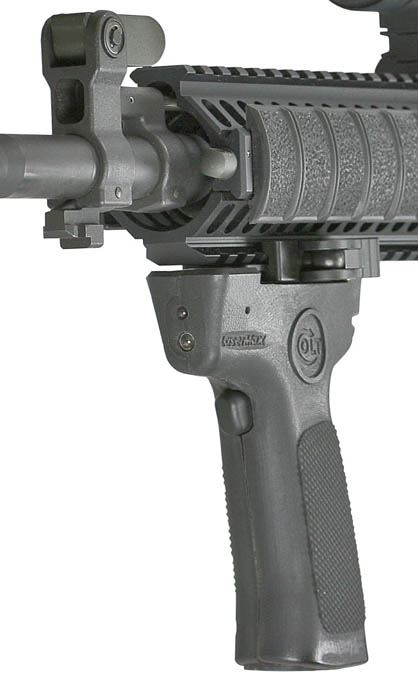
The CGL incorporates a vertical pistol grip, laser sight as well as a traveling light in one package. By a selector switch on the rear of the CGL, the unit may be set for the traveling light, off, constant beam laser as well as the pulsating laser. The CGL uses an American Defense QD Auto Lock mount. The CGL is activated by an activation switch on the front of the grip. By squeezing the switch slightly the unit will turn on momentarily. By squeezing all the way in, the unit will be continuously turned on until the switch is depressed and released. The unit is powered by two commercially available AA batteries.
The current offering is a 635nm laser that has an orange color. Constant as well as pulsating modes are available at discretion. Pulsating offers the benefit of battery life extension and is easier for the eye to pick up as it “irritates” the eye so it is more visible. There are several tactical applications for this option to include distinguishing ones laser apart from another. Given there is no play in the lower handguard, the CGL holds an alignment of 1/2 inch at 25 yards. Laser sights are designed for close quarter battle scenarios and not as precision long range targeting devices.

The traveling light is not to be confused with a tactical light. The LED traveling light is designed for low level brightness, which is used to view objects up close such as the floor in front of the operator or objects immediately in front of you. The T&E unit showed this very well. When entering a dark room and activating, the traveling light showed the ground and walls well; when switched to a tactical light, the whole room lit up.
The benefits of laser sights are many. First and foremost it is intimidation. Due to the use of the media, everyone knows if you see a red dot on you something bad is about to happen. The media has conditioned society to react that way to a laser. Laser sights offer law enforcement an option that may prevent them from firing their weapon when without it the outcome may have been quite different. The use of the laser also speeds up reaction and engagement time. It is more efficient to use a laser for quick fire situations than sights. Many times when under these circumstances the operator may not have time to shoulder his weapon and obtain a sight picture. The laser offers the shooter full use of peripheral vision to better know the situation and what is going on around him.
The laser is adjusted by two Allen key screws. An adjustment tool was provided with the CGL. The CGL was mounted to the front of the bottom rail of the LE6940. An Insight Tech Gear Laser Borelight System was placed in the muzzle projecting a laser of the centerline of the bore. The CGL was placed on pulsating laser mode and switched on. The CGL was zeroed with the Laser Borelight System at 15 yards. This distance was chosen because the tactical situations which the CGL truly shines are for engaging targets at close range. The CGL is shipped with one daylight zero target. This is a reflective target that allows the laser to be seen in broad daylight. Nifty idea since most indoor ranges will not allow a high power rifle.
At 15 yards, the laser was shooting within an inch off hand. Accuracy was acceptable and the speed of engagement of targets was enhanced. There were no problems with the CGL. More than 300 rounds were fired with no noticeable change in alignment.
Colt Defense has released a new Black Rifle as well as a new accessory this year. The industry has waited to see more new products from Colt and they will not be disappointed. Although U.S. government contracts must be the priority at Colt Defense, as of this writing, Colt Defense has been producing significant numbers of Law Enforcement and commercial rifles. Recently at AUSA, Colt Defense unveiled several of their new products including alternative operating systems as well as their monolithic upper receiver. Small Arms Review will certainly be on top of these developments as information is released.
(Small Arms Review contributing editor Christopher Bartocci works as a Technical Specialist for Colt Defense LLC. The articles written by this author are of his own research and evaluation and in no way represent those of Colt Defense LLC.)
| This article first appeared in Small Arms Review V12N12 (September 2009) |



